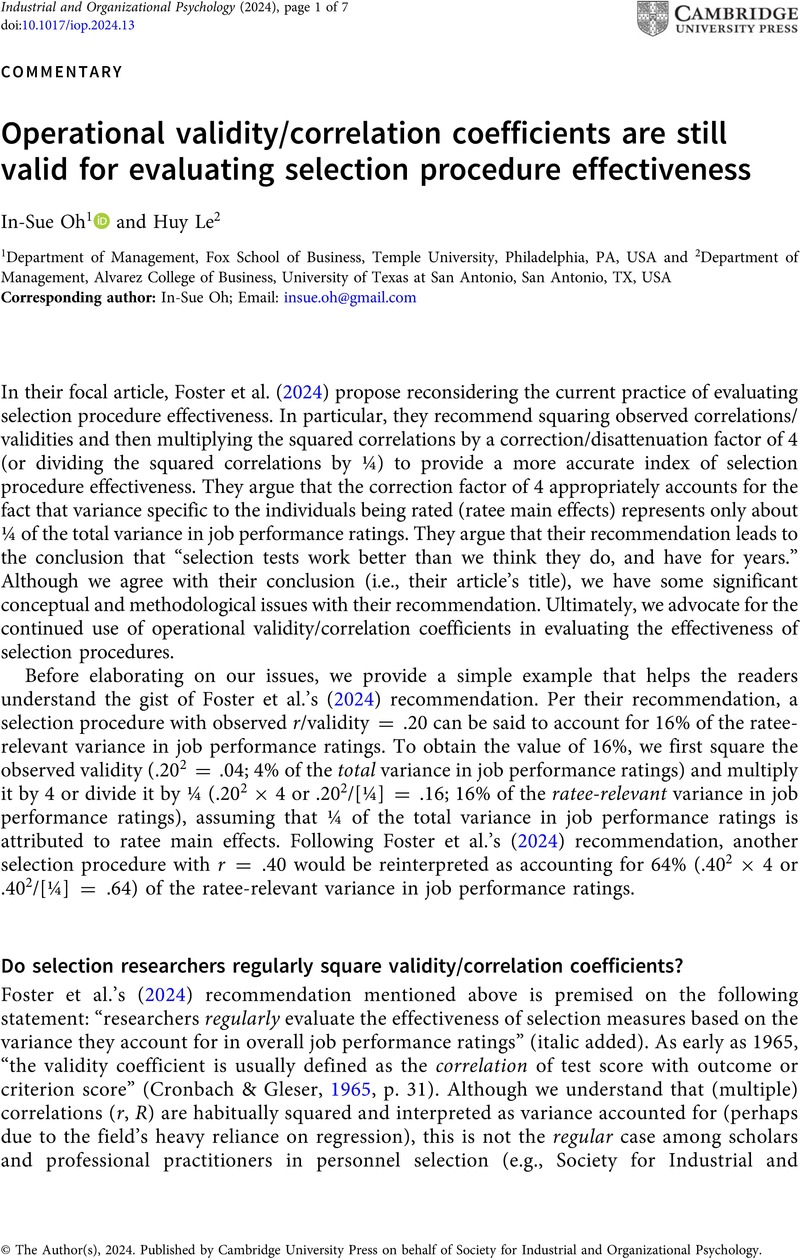No CrossRef data available.
Article contents
Operational validity/correlation coefficients are still valid for evaluating selection procedure effectiveness
Published online by Cambridge University Press: 29 August 2024
Abstract
An abstract is not available for this content so a preview has been provided. Please use the Get access link above for information on how to access this content.

- Type
- Commentaries
- Information
- Copyright
- © The Author(s), 2024. Published by Cambridge University Press on behalf of Society for Industrial and Organizational Psychology
References
Brogden, H. E. (1949). When testing pays off. Personnel Psychology, 2, 171–183.CrossRefGoogle Scholar
Cronbach, L. J., & Gleser, G. C. (1965). Psychological tests and personnel decisions. University of Illinois Press.Google Scholar
Foster, J., Steel, P., Harms, P., O’Neill, T., & Wood, D. (2024). Selection tests work better than we think they do, and have for years. Industrial and Organizational Psychology, 17.Google Scholar
Funder, D. C., & Ozer, D. J. (2019). Evaluating effect size in psychological research: Sense and nonsense. Advances in Methods and Practices in Psychological Science, 2, 156–168.CrossRefGoogle Scholar
Le, H., Oh, I.-S., Shaffer, J., & Schmidt, F. (2007). Implications of methodological advances for the practice of personnel selection: How practitioners benefit from meta-analysis. Academy of Management Perspectives, 21, 6–15.CrossRefGoogle Scholar
Oh, I.-S., Le, H., & Roth, P. (2023). Revisiting, Sackett, et al. ’s, 2022 rationale behind their recommendation against correcting for range restriction in concurrent validation studies. Journal of Applied Psychology, 108, 1300–1310.CrossRefGoogle Scholar
Oh, I.-S., & Schmidt, F. L. (2021). Suggestions for improvement in psychometric corrections in meta-analysis and implications for research on worker age and aging. Work, Aging and Retirement, 7, 167–173.CrossRefGoogle Scholar
Ree, M. J., Carretta, T. R., Earles, J. A., & Albert, W. (1994). Sign changes when correcting for range restriction: A note on Pearson’s and Lawley’s selection formulas. Journal of Applied Psychology, 79, 298–301.CrossRefGoogle Scholar
Sackett, P. R., Zhang, C., Berry, C. M., & Lievens, F. (2022). Revisiting meta-analytic estimates of validity in personnel selection: Addressing systematic overcorrection for restriction of range. Journal of Applied Psychology, 107, 2040–2068.CrossRefGoogle ScholarPubMed
Schmidt, F., Le, H., Oh, I.-S., & Shaffer, J. (2007). General mental ability, job performance, and red herrings: Responses to Osterman, Hauser, and Schmitt. Academy of Management Perspectives, 21, 64–76.CrossRefGoogle Scholar
Schmidt, F. L. (2017). Beyond questionable research methods: The role of omitted relevant research in the credibility of research. Archives of Scientific Psychology, 5, 32–41.CrossRefGoogle Scholar
Schmidt, F. L., & Hunter, J. E. (1998). The validity and utility of selection methods in personnel psychology: Practical and theoretical implications of 85 years of research findings. Psychological Bulletin, 124, 262–274.CrossRefGoogle Scholar
Schmidt, F. L., & Hunter, J. E. (2015). Methods of meta-analysis: Correcting error and bias in research findings. Sage.CrossRefGoogle Scholar
Schmidt, F. L., Shaffer, J. A., & Oh, I.-S. (2008). Increased accuracy for range restriction corrections: Implications for the role of personality and general mental ability in job and training performance. Personnel Psychology, 61, 827–868.CrossRefGoogle Scholar
Schmitt, N. (2007). The value of personnel selection: Reflections on some remarkable claims. Academy of Management Perspectives, 21, 19–23.CrossRefGoogle Scholar
Scullen, S. E., Mount, M. K., & Goff, M. (2000). Understanding the latent structure of job performance ratings. Journal of Applied Psychology, 85, 956–970.CrossRefGoogle ScholarPubMed
Society for Industrial and Organizational Psychology (2018). Principles for the validation and use of personnel selection procedures (5th ed.). Author.Google Scholar
Speer, A. B., Delacruz, A. Y., Wegmeyer, L. J., & Perrotta, J. (2024). Meta-analytical estimates of interrater reliability for direct supervisor performance ratings: Optimism under optimal measurement designs. Journal of Applied Psychology, 109, 456–467.CrossRefGoogle ScholarPubMed
Thorndike, R. L. (1949). Personnel selection; test and measurement techniques. New York: Wiley.Google Scholar
Viswesvaran, C., Ones, D. S., & Schmidt, F. L. (1996). Comparative analysis of the reliability of job performance ratings. Journal of Applied Psychology, 81, 557–574.CrossRefGoogle Scholar
Viswesvaran, C., Ones, D. S., Schmidt, F. L., Le, H., & Oh, I.-S. (2014). Measurement error obfuscates scientific knowledge: Path to cumulative knowledge requires corrections for unreliability and psychometric meta-analysis. Industrial and Organizational Psychology, 7, 507–518.Google Scholar




